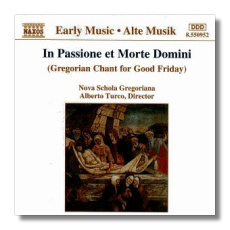
The Internet's Premier Classical Music Source
Related Links
- Latest Reviews
- More Reviews
-
By Composer
-
Collections
DVD & Blu-ray
Books
Concert Reviews
Articles/Interviews
Software
Audio
Search Amazon
Recommended Links
Site News
 CD Review
CD Review
In Passione et Morte Domini

Gregorian Chant for Good Friday
Nova Schola Gregoriana/Alberto Turco
Naxos 8.550952 1994 DDD 59:00
The ancient Good Friday liturgy, restored to its full splendor by Pope Pius XII in the 1950s, is one of the few Roman Catholic rites left relatively intact by sweeping post-Vatican II reforms. But the majestic Latin is now gone, as are some of the customs surrounding the Passiontide in general. Consider, then, a Good Friday service in the pre-conciliar Church. The ceremonies and texts, as well as the setting in which they took place, were especially rich in subliminal suggestions. The liturgical colors were black and, later in the rite, purple. The altars were stripped bare, the doors of the empty tabernacle were left open, and statues and crucifixes were hidden from view by purple cloths. The organ was silent, and wooden clappers sounded instead of bells. Unaccompanied chanters solemnly intoned texts alternately sorrowful and bitter, dramatic and poetic.
Only an actual selection of these texts in translation can convey the power of their impact. The ironic Reproaches comprise an insistent dialogue between the Crucified and the Church in verse after verse, for example: With the might of My strength, I lifted thee up, yet thou hast hung Me down from the gibbet of a Cross. My people, what have I done to thee or how have I offended thee? Answer Me? (Answer): Agios, o Theos! Sancte Deus! (O Holy God – Greek and Latin); Agios ischyros! Sanctis fortis! (O holy strong One!) Agios athanatos, eleison imas. Sanctus immortalis, miserere nobis. (O Holy, immortal One, have mercy on us.) For poetry, on the other hand, it's hard to match the hymn Crux fidelis: Faithful Cross, thou stand'st alone; None like thee our woods have grown; None can with thy growth compare, Nor leaves like thine, nor flowers bear. Sweet wood, sweet nails, Sweet is the precious weight ye bear. For austerity, consider the Tracts, and for drama, the Passion according to St. John, read in its entirety by three priests: one representing the narrator, a second representing Christ, and a third, the mob and other bit parts – or the unveiling of the Cross, in which Celebrant, Deacon and Subdeacon climbed the three steps to the altar one at a time, carrying a large crucifix and unveiling on each step successive portions of it until the corpus was entirely exposed to view. The chant, rising in pitch on each step: Behold the wood of the Cross upon which hung the Savior of the world. Come let us adore. This was liturgical action at its most intense, and the serenely unfolding hypnotic chants only heightened the drama.
Alberto Turco and the Nova Schola Gregoriana include a gradual and tract, the passion narrative, the chant for the unveiling of the cross, the reproaches, and Crux fidelis on a new disc in Naxos' excellent series of recordings of early music. The performances, recorded in the reverberant ambience of the parish church of Quatrelle in Mantua, are unexceptionable technically and texturally. But there lurks a suspicion that something is missing. Chant can be experienced fully only in conjunction with the sacred ritual, a truth perhaps especially pointed in this repertoire for the most solemn of days in the liturgical year. In the audio format of a CD, visual presentation is obviously impossible; but if these selections had even been recorded during actual ceremonies, some of the devotional aura at least might have been captured and preserved. In even the best case, however, video would be no substitute for live participation. I've heard these same chants "performed" by clergy and choirs who could barely find the correct pitches, yet they cut to the very bone. This performance is like a Witch of the North played by Ann-Margret instead of Margaret Hamilton. She might look good, but she couldn't look right. The notes are superb, but the Latin texts are left untranslated. Since Turco surmounts at least some of the difficulties of performing this music in vacuo, presenting the selections about as reverently as possible under the circumstances, the disc and its program can be recommended – but primarily for Turco's superlative musicality and for the intellectual pleasure of discovering the complex relationships of text and music.
Copyright © 1996, Robert Maxham


















